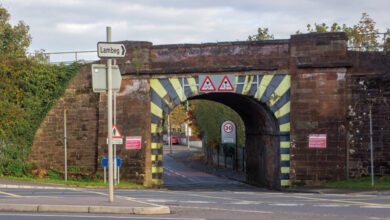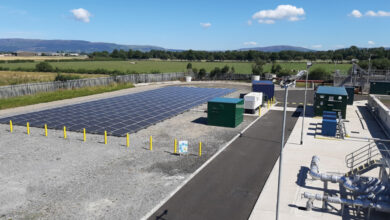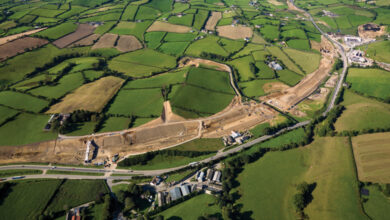Priorities for future infrastructure

Peter May, Permanent Secretary of the Department for Infrastructure, discusses planning for a future long-term infrastructure investment in the absence of a minister.
Describing infrastructure as the “bedrock of economic growth and productivity”, May outlines the important influence that key networked infrastructure has on social cohesion, as well as an economic enabler.
Within that role, May highlights three core features he relates to successful infrastructure development. These are:
- a clear vision/direction of travel – incorporating generational foresight in infrastructure planning;
- long-term adequate funding – including financing models; and
- good delivery capability – including for future transformational change.
Planning
On long-term planning, he points to two publications in both the UK and the Republic of Ireland which each outline visions to 2040. Firstly, the independent-of-government National Infrastructure Commission’s upcoming publication of a National Infrastructure Assessment, which will set out the non-devolved infrastructure needs in the UK, and secondly the Irish Government’s National Planning Framework published earlier this year.
Drawing comparisons between these long-term plans and the situation in Northern Ireland, where the Investment Strategy, published in 2011, is the main vehicle for outlining the current plans of Stormont, May says: “The five-to-10-year strategy is deliberately not seeking to take that over-arching strategic evidence-based view for a generation ahead and I think that this is a gap that we need to be filling here in Northern Ireland.”
May outlines that the Department for Infrastructure has proposals to put to an incoming minister to develop a ‘regional infrastructure delivery plan’, taking a view to 2040.
He adds: “When we were developing that, and I believe this still to be the case to some extent, it seemed to me that having political ownership of a programme of work, carried out independently from government but bringing the evidence back to ministers, would be an essential part of developing a long-term plan.”
However, May acknowledged that this approach assumed an end to the stalemate at Stormont.
“It (the continued stalemate) does however raise debate about political involvement going forward,” he explains. “I think there is an open question about whether we proceed (without a minister in place) and if so, how we get the political buy-in that’s needed.”
Funding
Northern Ireland invests half of what the rest of the UK invest in transport. On funding, May believes that governments have a set of political choices to make. These revolve around: what quality of service they wish to deliver and how best to pay for that service, whether that be through non-devolved direct taxation and indirect taxation or through local taxes; and to what extent the consumer is invited to pay.
Revenue raised as % of total running cost in Northern Ireland
- Roads 4%
- Water (non-domestic charges) 18%
- Public transport 53%
Pointing to the percentage of running costs raised through revenue of Northern Ireland’s transport and water infrastructure, May highlights that there are also other options available to any government as to how they seek to raise revenue from the consumer, recognising some like water charging, road tolling or congestion charging are controversial.
The second area where government has a choice to make is around the model of funding infrastructure and whether investment in infrastructure will be done via a state model, with most funding coming from the exchequer or from a model which draws on private sector financing and/or borrowing.
“There are consequences to these decisions and they are for politicians to take.”
Currently Northern Ireland has a mixed approach to the five main areas of networked infrastructure. Energy and telecommunications are largely a private sector model, whereas water, waste and roads are much more state-based systems. While both roads and water have utilised PPPs, as May points out, these have not been sufficient to overcome the infrastructure deficit here.
He adds: “There are consequences to these decisions and they are for politicians to take. There are some big challenges for the next minister for Infrastructure and Executive to decide how best to take forward these issues – including whether to continue with the policies that have been adopted to date or to take a different tack. A lot of that will depend on the scale of the ambition and whether that long-term sense of what is needed is incorporated.”
Current work
Turning to other work ongoing in 2018 and looking ahead, May highlights a focus on the three particular areas of the outcomes-focussed draft Programme for Government (PfG) which the Department is leading. These including the improvement of journey times on key economic corridors; increasing the amount of people using active travel; and driving up the performance of NI Water for the benefit of consumers.
He says: “Fundamental to the PfG is not simply about hitting those indicators but also looking at the wider impact such as the role water and transport can have on the environment, on the economy and on health.”
The Department’s priorities centre around the Executive’s flagship projects, four of which fall within their purview. These include the A5 (under legal challenge), the A6, the Belfast Transport Hub (Weavers Cross) and the Belfast Rapid Transit (Glider). He outlines that aside from the A5, good progress is being made on the other projects. He also says capital investment made by the Department is £100 million more than this time last year as a result of the confidence and supply agreement between the Conservative Party and the DUP.
Crucial to the future direction of the Department is the outcome of a legal challenge to the ruling that May’s green lighting of an energy from waste plant north of Belfast in the absence of ministers was ‘unlawful’. Asserting his belief that there will be wider economic consequences to the decision, he concludes by saying: “On its merits, we are appealing on the basis that we were entitled to take the view that the Department could make those judgements. However, as a minimum, the ruling should at least clarify what decisions it is possible to take in the absence of ministers.”






